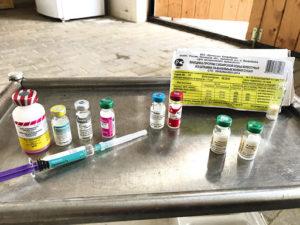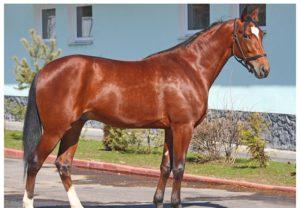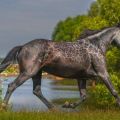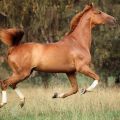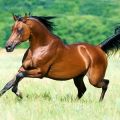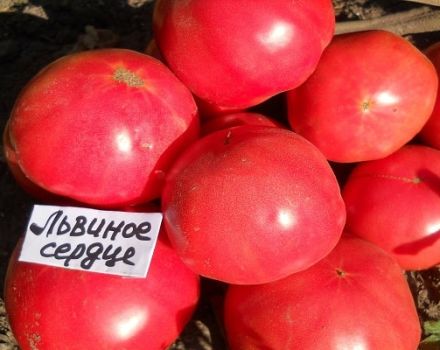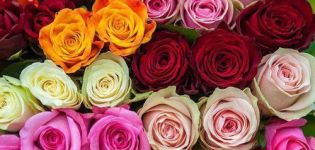Description and characteristics of Friesian horses, rules of care and how much it costs
Friesian horses are called black pearls or black gold due to their silky coat and smooth curve of the neck. The Dutch breeding species was on the verge of extinction, but now the number of Frisians in the world has increased. The noble exterior aroused the interest of breeders in the breed. The developing mane and shaggy hooves transform the galloping Friesian horse into the personification of unstoppable strength.
How the breed was born
The homeland of Friesian horses is Friesland, an area in the Netherlands. The breed was bred in the 16-17 centuries by crossing local cold-resistant heavy trucks and heat-loving Spanish Andalusians. The ancestors of modern friezes were not distinguished by grace. They were used as draft animals and for riding. The warriors went into battle on horses of the Friesian breed. Powerful horses withstood the weight of a knight in armor.
Medieval Holland was dependent on the economy, trade and martial law in Europe. The exterior and strength of the Frisians varied in accordance with the political situation. Breeders improved the quality of their horses with European and Oriental breeds.
During the period of Spanish rule, the Dutch army did not need heavy war horses. The Frisians were made easier by crossing with Berber and Andalusian breeds. The result is an agile, versatile horse suitable for war, sports and parades. In the 18th century, the Frisians were gradually replaced by riding breeds. By the 20th century, their numbers had declined. But even royal immunity and the keeping of a studbook did not save the Dutch horses from degeneration.
To prevent the Friesians from disappearing completely, as well as due to the lack of purebred individuals, they were crossed with other breeds.
As a result, the original medieval grace of the Dutch horse has suffered. The legs are shorter and the body is more massive. At the end of the 20th century, Europe again became interested in noble breeds. Friesian horses are some of the most beautiful in the world.
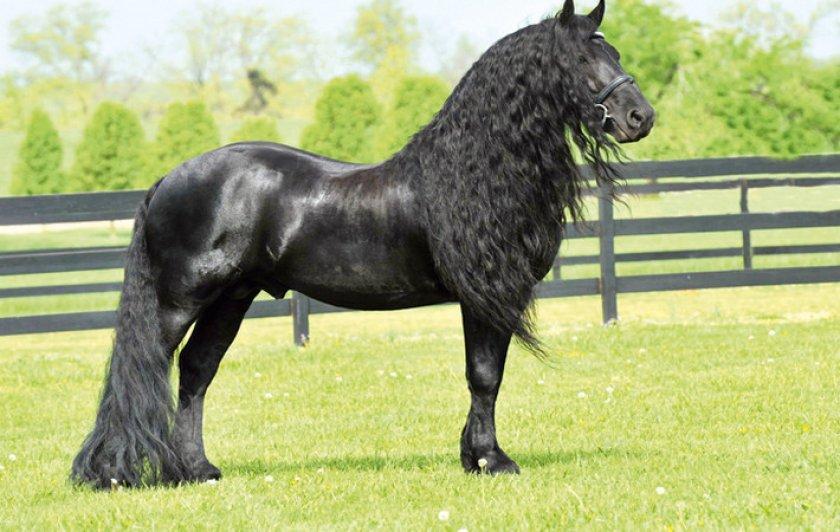
Advantages and disadvantages
The Friesian horse is hardy, graceful, of medium height, harmoniously built. The animal walks with a soft gait, comfortable for the rider.
Positive qualities of friezes:
- ceremonial appearance;
- bend of the back comfortable for sitting;
- complaisance.
The negative aspects of the Friesian breed are related to the content and use:
- complex diet;
- laborious daily care;
- sensitivity to imperfect living conditions and unhealthy diet;
- external data prevail over physical and intellectual abilities.
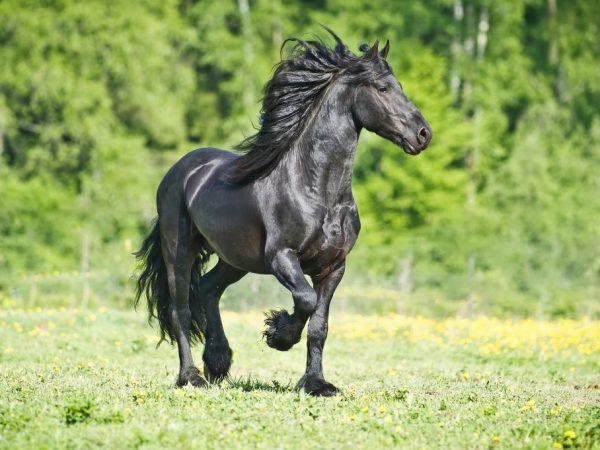
Friesian horses are beautiful, obedient, but not smart. For team competitions and horse racing, jockeys prefer more agile, unpretentious breeds in grooming. Due to the time-consuming grooming, Friesian horses are also not suitable for touring groups traveling over rough terrain. Lush mane, tail and legs are difficult to clean from small forest and field debris.
Full description and exterior
External characteristics of the breed:
- growth at the withers - 150-162 centimeters;
- black suit;
- heavy body;
- wide back;
- deep loin;
- elongated croup;
- arched high neck;
- large elongated head;
- straight profile;
- elongated sharp straight ears;
- powerful legs;
- the hind hooves are narrower than the front;
- legs below the knee joint are covered with long hair.
The sporty Friesian horse adopted the high stature and lightness of the Andalusians. A thick mane, tail and long hair falling over the hooves are the distinguishing features of the friezes.
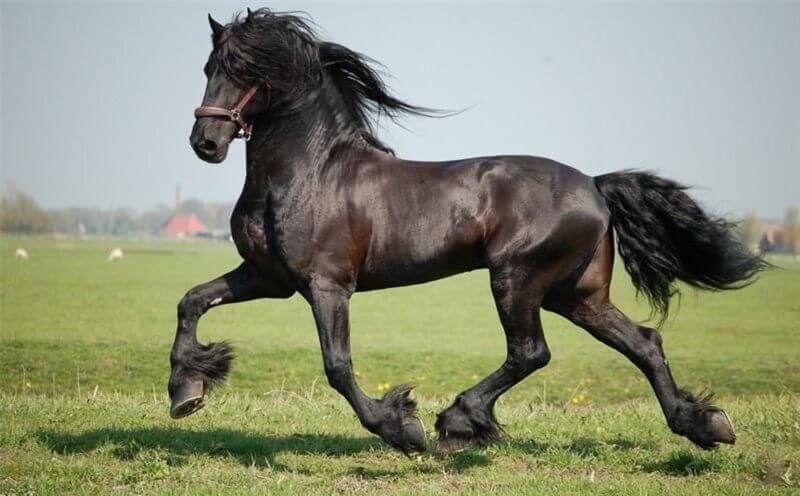
In addition to the exterior, the breed standard includes the quality of the gait:
- step - four-stroke, uniform;
- trot - two-stroke, with a long flight phase.
Friesian horses run smoothly, in a carriage ride, raising their legs high. The speed on level ground is lower than on a thin layer of snow.
Varieties and suits of friezes
Dutch horses are divided into three types of exterior:
- baroque - individuals with a pedigree stretching from the first representatives of the breed, look noble, differ in a thick mane, high gait;
- sports - it has a short back, dense body, but a small lung volume does not allow to participate in races;
- modern - an intermediate type between light sporty and powerful baroque.
The standard color of the friezes is black. Sometimes females have a white mark on the forehead - "asterisk", not exceeding 3 centimeters in diameter. Blotches are unacceptable for males.
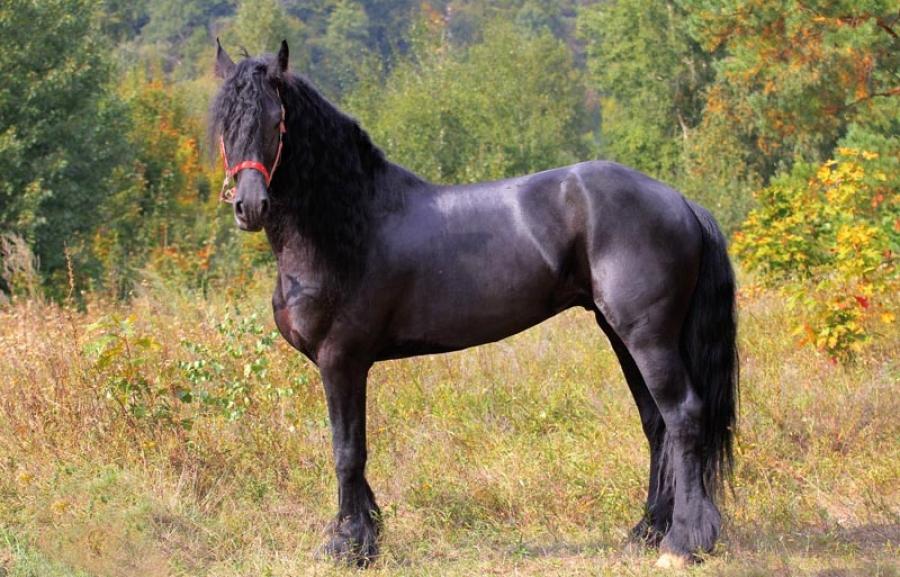
White or red foals are born by mixing the Friesian breed with the Eastern or American. A light shade with a gray tint is obtained when crossed with an Arabian horse. Mestizo foals from the Appaloosa breed look like friezes of a forelock suit.
The nature and learning ability of the animal
Friesian horses are quick-witted, adapting to the rider. The breed is best suited for learning to ride from scratch. Friezes are energetic and balanced, not afraid of loud sounds and crowds. They can be trained in different types of gait. The phlegmaticness of the Dutch and the expressiveness of the Spanish ancestors combined in the sanguine temperament of the Frisians.
Where are horses used?
The road to sports is not closed to the friezes, although more often handsome men are in demand in the entertainment field. Areas of use:
- urban tourism;
- driving;
- circus art;
- event industry.
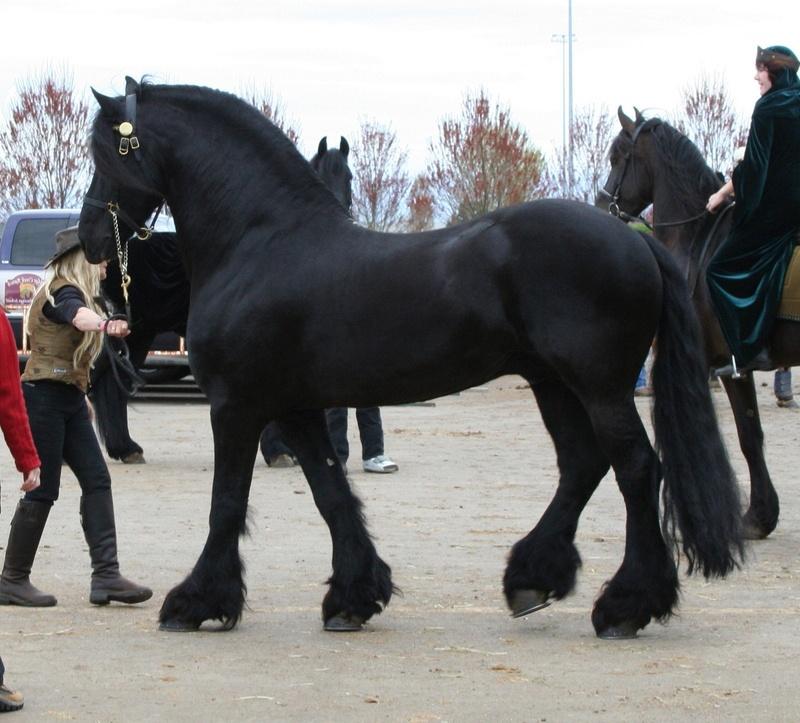
Friesian horses are bought for keeping in private stables and riding. Majestic handsome men are harnessed to pleasure carriages, carriages for special events.
Features of the content
Friesian horses need a balanced diet, cleanliness and warmth in the stall to feel good.
Stable
Favorable conditions for friezes:
- temperature - 16-20 degrees all year round;
- ventilation, fresh air;
- lack of drafts.
The size of the stall depends on how much time the horse spends in it. Breeders sometimes equip two places - winter, 3x4 meters, and summer, 3x2.5 meters.

Feeding and drinking
The Friesian horse's menu consists of herbs, grains, vegetables and minerals. Elite breed cannot be fed with compound feed for large livestock. The finished mixture contains substances that cause indigestion. The daily intake is calculated individually according to the horse's weight and physical activity.
Seasonal Friesian Feeding Schedule:
- 3 times a day in winter;
- 2 times a day in summer.
Feed is given at the same time of day and evening. Feeders and drinkers are set at the level of the horse's chest. The dishes are washed daily and disinfected once a month.Stationary drinkers will provide animals with 24/7 access to clean water.
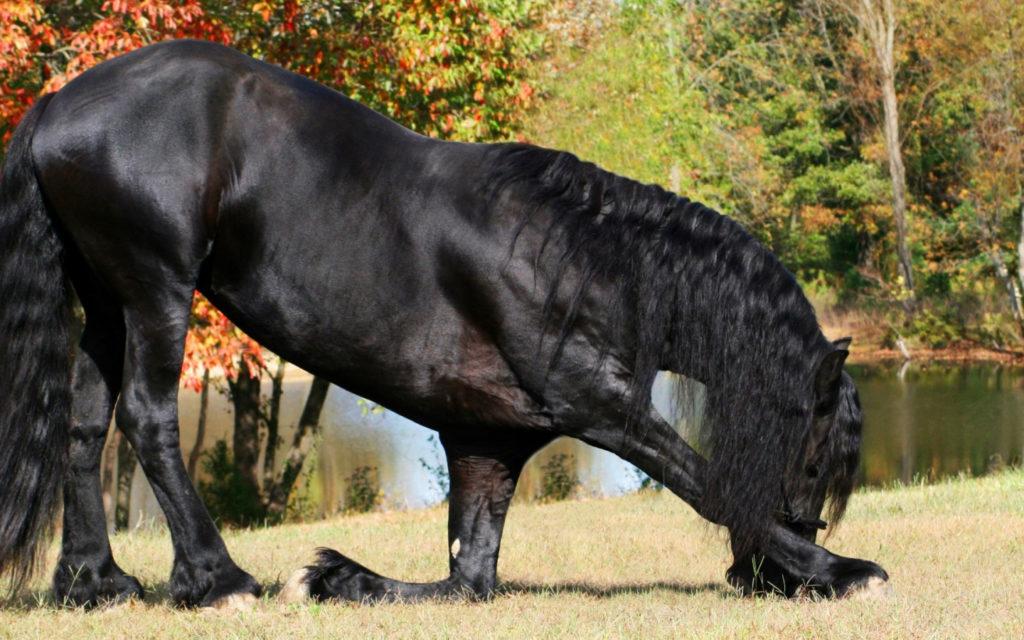
Horses
Food composition for Friesian stallions and mares of all ages:
- bran;
- wheat;
- corn;
- whole oats;
- crushed barley;
- carrot;
- potatoes;
- raw or boiled beets;
- salt.
Feeding order:
- roughage - hay, grass;
- juicy vegetables;
- cereals.
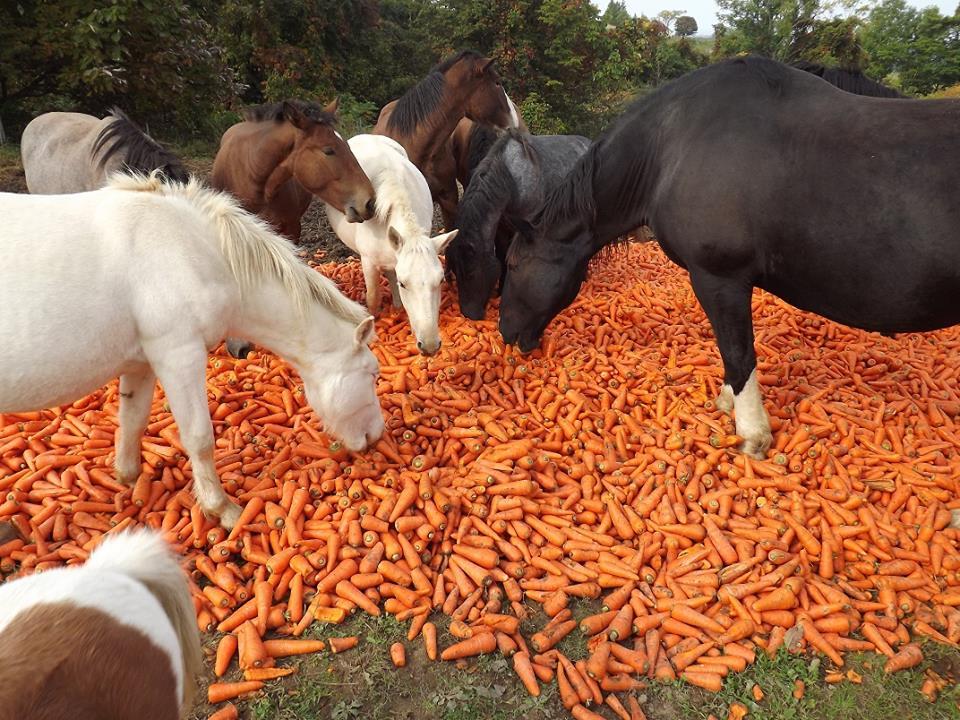
Perennial herbs are added to the hay. Healthy food for friezes is muesli. If the diet lacks vitamins and minerals, animals eat earth, sand, lick the whitewash.
Foal mares
Pregnant Friesian mares need vitamins A, B, E, as well as calcium and phosphorus. Add to the diet:
- corn;
- silage;
- cake;
- sprouted grain.
In the summer, mares are released to pasture for 6 hours a day. At any time of the year, they need to be given more carrots.
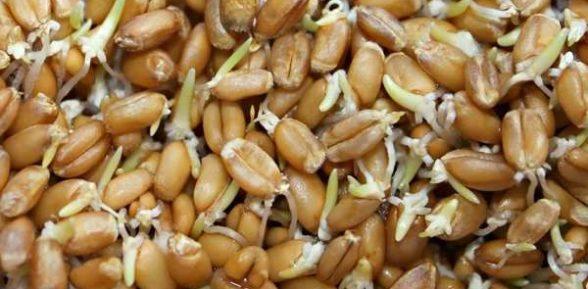
Body and mane care
The mane, tail and woolen brushes on the hooves are the pride of the friezes, so the appearance of the animals is carefully looked after. Dutch horses are never cut, otherwise their appearance loses its greatness. Daily care includes:
- combing the mane and tail with a comb;
- cleaning wool with a scraper.
In the sultry summer, horses are given a warm shower. Cold water is contraindicated for friezes, as well as drafts. With the first cold weather, water procedures are canceled. The mane and tail are washed with shampoo once a week. Coarse horsehair is easier to comb with conditioner. The product is applied to the mane and tail every 2-3 days.
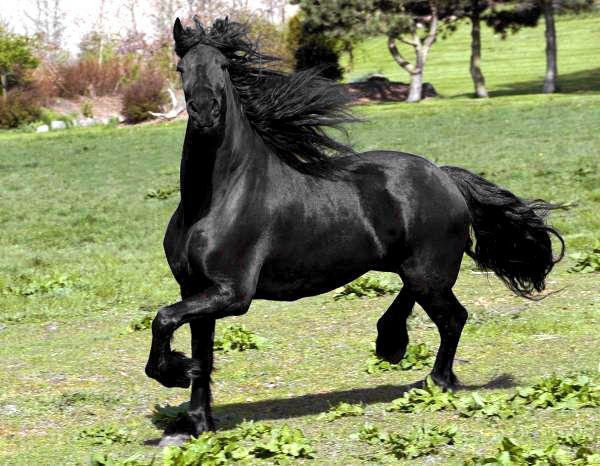
Disease prevention measures
Friezes are sensitive to changes in temperature, diet, toxins.
How to keep animals healthy:
- bring for a physical examination to the veterinarian every six months;
- follow the vaccination schedule;
- monitor behavior;
- independently examine teeth, hooves, eyes and ears;
- chase worms every six months;
- treat wool with insect repellents in summer;
- keep the stalls clean.
Friezes are vaccinated against the following diseases:
- rabies;
- tetanus;
- flu;
- herpes;
- encephalomyelitis.

Symptoms of oral problems include drooling, chewing on one side of the jaw, and refusing solid feed. Friesians' teeth grow throughout life. Difficulty chewing solid foods is caused by malocclusion or gum disease.
During the walk, you need to make sure that the Friesian horse does not gorge on unknown berries and plants. Signs of poisoning are refusal to eat, diarrhea, and lethargy.
Breeding features of the breed
The chance of natural pregnancy in Friesian mares is 15%. For breeding, artificial insemination is used. The mating season for the Frisians lasts from March to June. The gestation period is 11 months. Childbirth is difficult, often with a cesarean section.
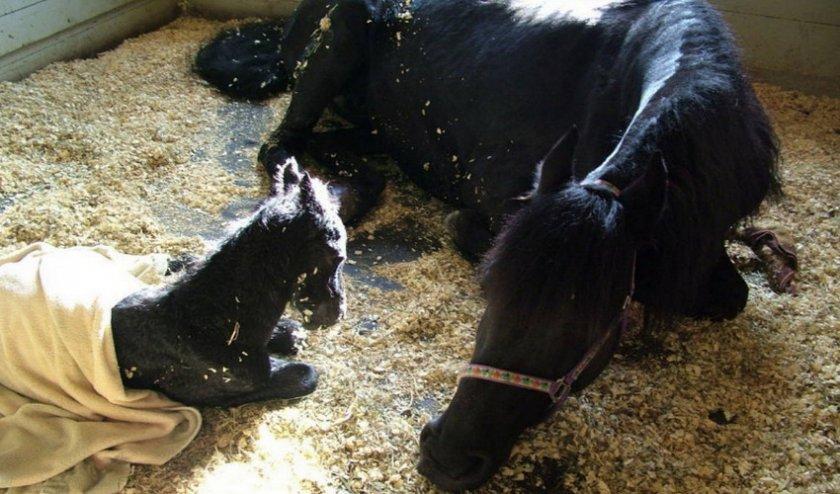
Interesting facts about the Friesian horses
The majestic Dutch horses have left their mark on the history of horse breeding and the world:
- by order of the Emperor of Germany Wilhelm I, in the 18th century, a Frisian race was held - "The Day of the Royal Whip";
- since 1985, Dutch horses have been harnessed to Queen Elizabeth's carriage at the annual opening ceremony of the British Parliament;
- in Britain, a long-lived horse became famous, which lived for 50 years. On average, the Friesian breed lives for 25 years;
- friezes are fabulous horses. They are harnessed to princess carriages at Disneyland;
- Friesian horses have counterparts - Fell ponies. They have the same hoof brushes and long manes.
Owners can release friezes onto the overgrown lawn. Animals will cope with green growth better than a lawn mower. For good work and obedience, Dutch beauties are pampered with their favorite delicacy - sugar.
The cost
The price depends on the availability of the pedigree and the country of the seller. The main supplier of the Friesian breed is the Netherlands. The minimum price for a horse from a Dutch nursery is 10 thousand euros, excluding delivery.
There are few equestrian organizations in Russia specializing in the breeding of Frisians. In the Moscow region, KSK Svetozar and Kartsevo are known. You can see the applicants on the websites of the complexes. How much is the stallion or mare you like, you need to specify separately when buying.
Freeze can be purchased from a private seller through online message boards. Prices for titled horses with pedigree on sale and purchase sites range from 350 thousand to 1.5 million rubles. The owners appreciate the sporting achievements and abilities of their pets.
